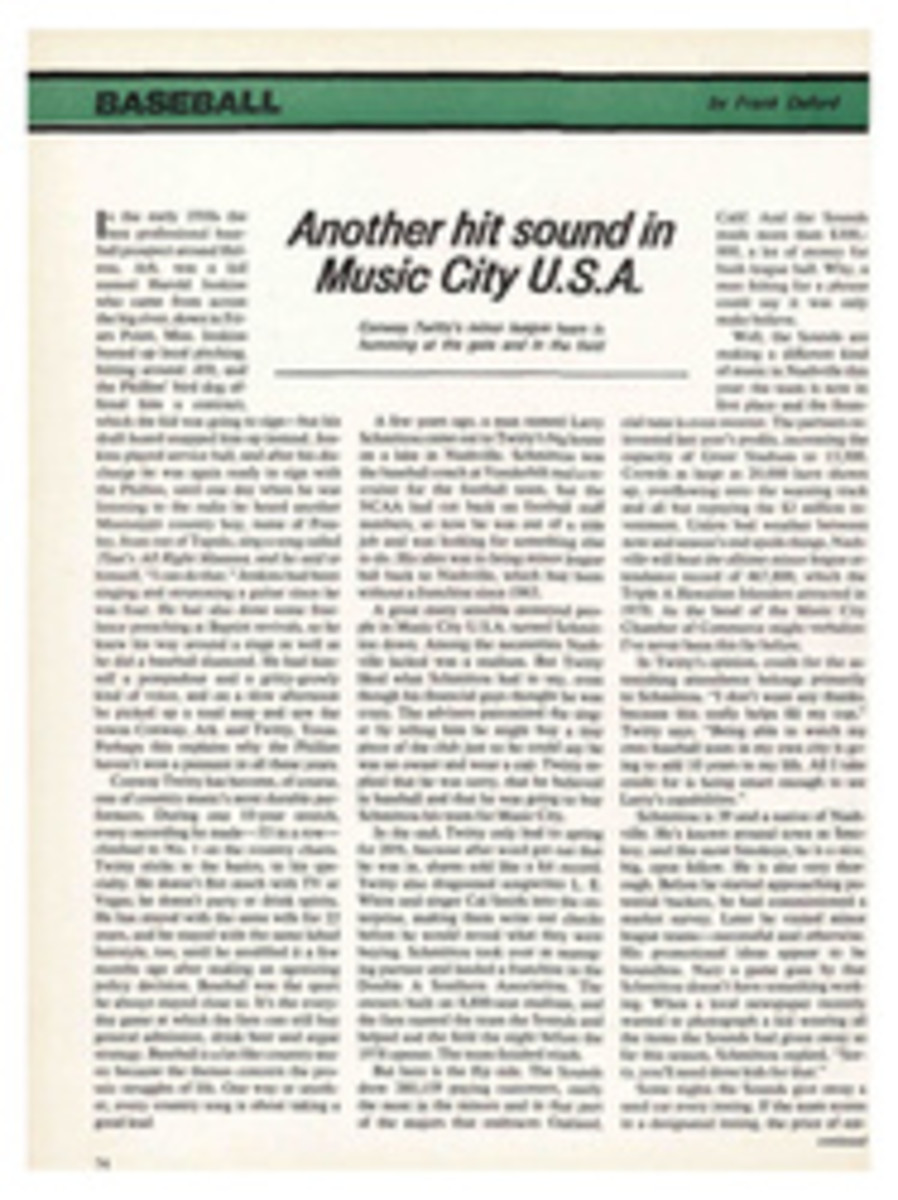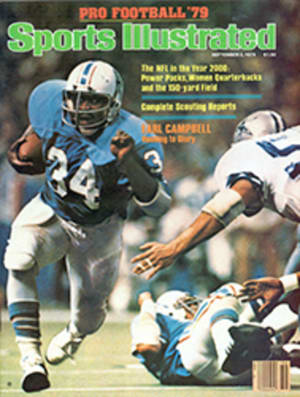
AFC Central
The AFC Central is the league's best division. You can look it up. Last year it not only produced the Super Bowl champion Steelers, as well as their rivals in the AFC championship, the Oilers, but it also had the best combined winning percentage—.563—of any of the NFL's six divisions.
Despite the AFC Central's overall quality, no team is likely to unseat PITTSBURGH. The primary reason: Quarterback Terry Bradshaw, who at 31 has become the game's most dynamic offensive performer. Last year Bradshaw led the NFL with 28 touchdown passes and threw eight more in three playoff games. The Steel Curtain used to be king in Pittsburgh, but Bradshaw has usurped it.
He has the NFL's most complete arsenal at his command, and he operates behind an aging but vastly underrated offensive line. When Bradshaw wants to stay on the ground, he simply hands the ball to Franco Harris, who this year can tie Jim Brown's record of seven 1,000-yard seasons. If Harris rambles for 1,221, he will move into third place on the alltime rushing list behind Brown and O. J. Simpson. At the other running back spot, Coach Chuck Noll plans to spell Rocky Bleier, a superb blocker but hardly a breakaway threat, with third-year man Sidney Thornton and first-round draft pick Greg Hawthorne.
Defenses concentrate on stopping the Steeler ground game, though it lacks a game-breaker, so Bradshaw calls a lot of play action passes. Last season, for the second straight year, Pittsburgh gained more yardage in the air than on the ground. Wide receivers Lynn Swann and John Stallworth, who caught a total of 20 TD passes, rate as the best tandem in the NFL. The targets at tight end are just as good: Bennie Cunningham was asserting himself as one of the NFL's best when a knee injury sidelined him at midseason; his replacement, Randy Grossman, came on to make 37 catches.
The Steelers' only offensive shortcoming was in the field-goal department. Roy Gerela had his worst year, hitting just 12 of 26 tries, and now has lost his job to Matt Bahr, who converted 18 of 19 field-goal attempts from 40 yards or closer while at Penn State last season.
The Steeler defense is solid and deep, too. Pittsburgh stops the run better than any other AFC club. Mean Joe Greene still makes meaningful contributions, but the standout lineman now is Defensive End L. C. Greenwood. And the linebacking corps is, in a word, the best. Jack Lambert in the middle and Jack Ham on the outside are All-Pros. Because of the strength of the Steelers' line and linebackers, most opponents are forced to go to the air. But here, too, Pittsburgh is tough. The line applies pressure on the quarterback, and Noll puts on extra heat by ordering lots of blitzes. The secondary was already the best in the division, and now it has been strengthened by the return of Cornerback J. T. Thomas, who was out last season with a blood disorder. Ron Johnson, the No. 1 draft pick in 1978, played so well that the Steelers hardly missed Thomas.
One year ago HOUSTON signed Earl Campbell to a $1.4 million contract, the richest ever for an NFL rookie. Campbell would have been cheap at twice the price. He quickly established himself as the game's best running back by gaining 1,450 yards on the ground, becoming the first rookie to lead the league in rushing since Jim Brown in 1957. He is also the No. 1 reason why the Oilers, who otherwise are just an average team, went to the playoffs in 1978 and may well go again this year. The No. 2 reason is Quarterback Dan Pastorini, whose talent is surpassed only by his urge to self-destruct. In eight seasons in Houston, Pastorini has been involved in numerous car and boat wrecks. This year he has bought a motorcycle.
Pastorini had his best season in 1978, throwing for 2,473 yards and 16 TDs. His favorite target was Wide Receiver Ken Burrough, who caught 47 passes. The Oilers can expect improved field position if the game's top kick returner, Billy (White Shoes) Johnson, fully recovers from knee surgery. However, Coach Bum Phillips has no plans at present to use Johnson on kick returns, preferring to keep him healthy for pass-receiving work.
Last year the Oiler line earned the dual distinction of opening the holes for the league's top rusher and giving Pastorini the NFL's best pass protection. Then, in training camp, Houston lost Tackle Greg Sampson, its finest lineman, after emergency brain surgery for a blood clot. In addition, Guard George Reihner came down with a bad knee and will miss three games. But just as Campbell probably was wondering who would be opening the holes for him, the Oilers gave their No. 1 and No. 6 draft choices in 1980 to New England and came home with All-Pro Tackle Leon Gray, a superior blocker.
Although Houston had a 10-6 record in 1978, it gave up more points than it scored. Led by linemen Elvin Bethea and Curley Culp, both of whom will be 33 this season, and linebackers Robert Brazile and Gregg Bingham, Houston's 3-4 alignment was effective against the run, but the pass defense was strictly a no-show. Phillips used his top two draft picks for two massive defensive linemen, Jacksonville State's 6'4", 256-pound Jesse Baker and Iowa State's 6'5" Mike Stensrud, but Stensrud arrived at training camp weighing more than 300 pounds. Phillips plans to help his weak secondary in passing situations by using both Baker and Stensrud in a four-man line that should put more pressure on opposing quarterbacks.
Cincinnati will be a far better team than the dispirited crew that had a 4-12 record in 1978. In large measure the Bengals' problems were caused by a broken bone in Quarterback Ken Anderson's throwing hand that sidelined him for four games and limited his effectiveness thereafter. Anderson threw a career-high 22 interceptions. His injury underscored several Bengal weaknesses, most notably a lack of depth at quarterback and a feeble running attack.
Cincinnati moved to correct those flaws with its two first-round draft choices, selecting Washington State Quarterback Jack (the Throwin' Samoan) Thompson and LSU Running Back Charles Alexander. The Bengals think so highly of Thompson that before training camp got under way they released their holdover backup quarterbacks, John Reaves and Rob Hertel. As for Alexander, at 6'1" and 221 pounds he has the size and speed Archie Griffin lacks.
When Anderson and Thompson do go to the air, they have two premier deep threats in Isaac Curtis and Billy Brooks. With his second-round draft choice, Coach Homer Rice shored up a weakness at tight end by drafting 6'4", 238-pound Dan Ross from Northeastern. Ross blocks well and is fast enough to go deep.
Opponents generally have to travel a ways to score against Cincinnati. Bengal Punter Pat McInally led the NFL with a 43.1 average and put 25 kicks out of bounds inside the 20-yard line. Traveling any distance against Cincinnati proved difficult once last year's first-round draft choice, Defensive End Ross Browner, joined the starting lineup at midseason. Even though he missed the first seven games with a detached biceps in his right arm, Browner led the club in sacks with nine. He teamed with tackles Eddie Edwards and Wilson Whitley, both first-round picks in 1977, to give the Bengals the most promising defensive line in football.
Will the real CLEVELAND Browns please stand up? Last year the Browns played solid defense, but had trouble scoring while splitting their first eight games. Then, while splitting their last eight, they scored almost at will, but their defense fell apart. Appropriately, Cleveland's highlight film was entitled A Roller Coaster Ride. Now, says Coach Sam Rutigliano, "We want to get off the roller coaster and get on an express that doesn't make as many stops."
The only thing that stopped the Browns' offense in 1978 was the Browns' offense. Cleveland was the most heavily penalized team in the NFL (2,280 yards) and lost the most fumbles (29). The Browns were also hurt by the leg contusion that sidelined Running Back Greg Pruitt, the heart of their offense, for all of four games and portions of two others. Cleveland lost four of those six. Pruitt still rushed for 960 yards and caught 38 passes for 292 more. His backfield mate, Mike Pruitt (no kin), is no slouch either, as he showed with a 173-yard game against Buffalo.
Although he has a weak arm, Quarterback Brian Sipe passed for 2,906 yards and 21 touchdowns. He has a deep threat at tight end in Ozzie Newsome and two good wide receivers in Dave Logan and Reggie Rucker, who averaged 20.8 yards while making a club-leading 43 catches. Now Sipe has yet another top target in first-round draft choice Willis Adams, a burner from Houston.
On defense the Browns are average against the run but well below average at stopping the pass; last year they allowed more pass completions and passing yardage than any other NFL team. Rutigliano has made one change in the secondary, moving Cornerback Clarence Scott to strong safety, where he will play alongside All-Pro Free Safety Thorn Darden, who led the league in 1978 with 10 interceptions. Rutigliano feels that the main problem with Cleveland's pass coverage was that opposing quarterbacks could count the house while waiting for receivers to get open. To strengthen the pass rush, he traded for two veteran defensive ends—30-year-old Lyle Alzado of the Denver Broncos and 34-year-old Jack Gregory of the New York Giants. He is also counting on a much better performance from onetime All-Pro Defensive Tackle Jerry Sherk, who was ineffective last season following knee surgery in 1977.
ILLUSTRATION
Bahr: A kick for the Stealers.
ILLUSTRATION
Ross: Claws for the Bengals.
Predicted Finish
PITTSBURGH 12-4
CINCINNATI 9-7
HOUSTON 8-8
CLEVELAND 8-8

